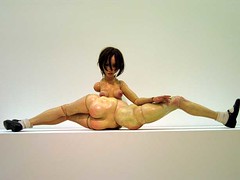Temples
Many smarter than I (Hans Belting is a favorite) are fond of reminding us that the museum has changed, radically, in pomo times: it is seldom the temple that it once was, where one visited canonical artworks that one's parents visited. (It now serves as, among other things, a site for mind-expansion, entertainment, and the primary place where art discourse is practiced--fodder for another discussion. Sometimes cognition leads one away from contemplation.)
In January I had the good fortune to visit the Centre Pompidou, perhaps the great temple of modernism, and I was reacquainted with many old friends and introduced to some new ones. Some familiar favorites:
- Anselm Kiefer's beautiful, lyrical, and rigorous Secret Life of Plants (0 1 2 3 4 5 6 7 8 9) document the Western artist-scientist's attempt to encompass all of knowledge within the bounds--actually, sometimes exceeding the bounds!--of the canvas.
- The exquisite quiet of Joseph Beuys's Plight (0 1 2 3), a grave, tomblike space that smells of felt--great rolls of the material fill the room--and contemplates loss.
- Kasimir Malevitch's great iconic Black Square and Black Cross; with staggering foresight (1915! Christ!), pinning down the ephemeral religious impulse for all to see.
- Jean Dubuffet's groovy and inviting Winter Garden installation.
- "Breton's Wall": the great surrealist provides a glimpse into an active mind (the Pompidou's website provides an encyclopedic inventory of the Wall's contents).
- I guess it makes sense that the French would take Jean Tinguely more seriously than we do, but I've always enjoyed their collection of his work, especially the self-destructing sculptures (I couldn't find them this time, but enjoyed Requiem pour une feuille morte, a really cool outsized diorama).
But there were exciting discoveries, too, foremost among these a fantastic exhibition by Thierry de Cordier, Belgium's representative to the 1997 Biennale. A small projects space was filled with more than a hundred of de Cordier's drawings and two of his sculptures, coffinlike structures he likens to "shelters." The drawings (samples here: 0 1 2) incorporate photographs, collage, letters, poetry, and type, but almost always concern the land--many of them depict falling snow, and are concerned with forms of de Cordier's shelters (samples here: 0 1 2). [For those interested in more images, but I purchased the beautifully executed and bound exhibition catalog.] One of my favorites was a pine "shelter," blackwashed, with an old 78rpm phonograph record incorporated at the end, so one could look inside the box. The feeling that something profound was occupying the gallery was unshakeable and inspirational.
Two paintings from 1933 by Balthus, Alice and La toilette de Cathy, were terrific.
Finally, on display was La poupée [inset], one of Hans Bellmer's dolls (museum images here: 0 1 2 , but they're not very good quality); I'm not very familiar with Bellmer's work, but the sculpture is reason enough to dig. This beautiful and disturbing subject of Bellmer's photographs--along with Balthus's work--promises a complex and human treatment of sexuality.



































1 Comments:
Great posts! One interesting aspect of Bellmer's doll sculptures is their relation to the troubled Surrealist author Unica Zurn, on whom some of them are based. I just read about this recently. I can't wait to see de Cordier's work in a gallery or museum, but I do discern a relationship between his work and that of his late compatriot, Marcel Broodthaers, highly championed by the OCTOBER crowd.
Post a Comment
<< Home